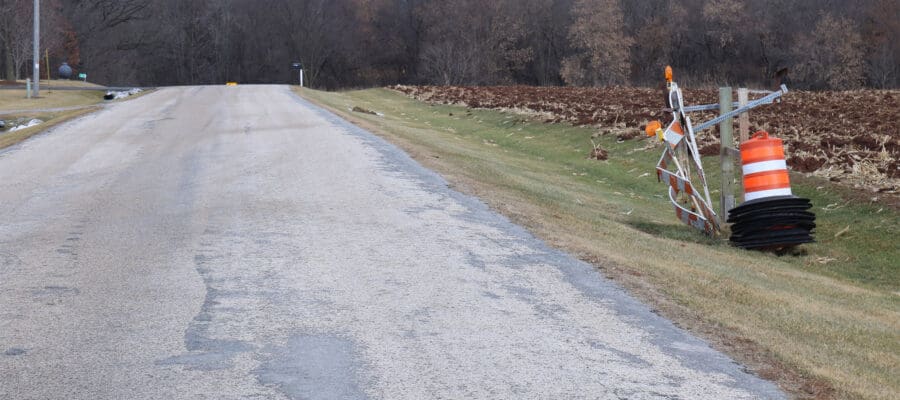Brian Roebke photo
Wrightstown Road from River Oaks Road west to the bridge floods so often Brown County Highway Department has left barricades there so they can be put up quickly to keep vehicles off that stretch of road because water flows over the road whenever there is more than an inch of rain.
By Brian Roebke
Editor
The solution to the flooding problem on Wrightstown Road in the town of Wrightstown may cost millions of dollars.
Town of Wrightstown Chair-person Bill Verbeten told board members at last week’s town board meeting they may have to do a study of the entire East River Watershed, both upstream and downstream, before they take any action to solve the flooding.
The area from River Oaks Road west to the bridge floods so often Brown County Highway Depart-ment has left barricades there so they can be put up quickly to keep vehicles off that stretch of road because water flows over the road whenever there is more than an inch of rain. The water is also washing out the bank of the river.
Compounding the problem is someone recently cut some trees down on the bank, weakening it even more.
In the winter, ice shoves can land on the road, making it impassible until heavy equipment can be brought in to remove the ice.
The town received engineering estimates from Robert E. Lee & Associates on the bridge, and they said another company must come in to complete a study of what the best options are for that river.
Among the solutions are raising the road or changing the route.
The question about the study is how it’s funded, and the Federal Emergency Management Agency should be the answer, with a 90-10 percent cost share.
“They guaranteed us it should be funded,” Verbeten said.
Wrightstown and the adjoining Town of Rockland would be the applicants, with Wrightstown doing the filing with the Wisconsin DNR.
The cost estimate for the study is between $30,000 and $330,000 and the study could take more than a year.
“They said you need to have the study before you apply for the FEMA grant,” Town Clerk Donna Martzahl said.
Supervisor Ron Diny is leery of doing the study but then not having enough money to fund the work to solve the problem.
Supervisors wonder if the large amount of drain tile farmers are installing in their fields might be the problem.
Water that used to drain down into the ground is now being diverted into ditches, then flowing into the streams and river.
There’s also been concern about water coming out of the digester into the river, but that won’t be known until later, and it may never happen since farmers want as much water returned as they can.
In incorporation news, the town is continuing to move forward and are waiting for Brown County Judge John Zakowski to allow them to set a date for a referendum.
“It’s got to be one step at a time,” Verbeten said. “We’ve been held back for so long, now have to keep moving ahead.”
The Village of Wrightstown has officially rescinded a lawsuit against the town and Wisconsin Incorporation Board, and Zakowski needs to approve that.
“He can still deny it according to what our legal counsel said,” Verbeten noted.
Verbeten also gave an update on the BC Organics operation based on information he got from their weekly construction and startup meetings.
The water treatment operation is starting, the gas flare was supposed to be running this week, they are getting manure in by trucks and they are making sure the meters are working correctly.
They tested Country Aire’s incoming manure line and when they returned the water back to the farm.
From there, they run it back through the water line. “It took them a day and a half to fill that line from Country Aire to the digester,” Verbeten said.
They are having some trouble pulling the fiber optic line to Seven Oaks Dairy. It’s going pretty slowly.
Verbeten is still waiting for a list of the farms trucks are coming from and the routes they are taking.
“I don’t care if it’s county, state, or town, we have to know,” he said.
After Treasurer Sheila Bowers gave the financial report, Super-visor Diny pointed out the Wrightstown school tax payment is more than all the town, county, and technical school tax all put together.
Plan Commission Chair Richard Gerbers reported the commission approved having up to 4 percent of a lot for out buildings in ag residential zoned areas. That’s almost double what’s currently allowed for a two acre lot.

